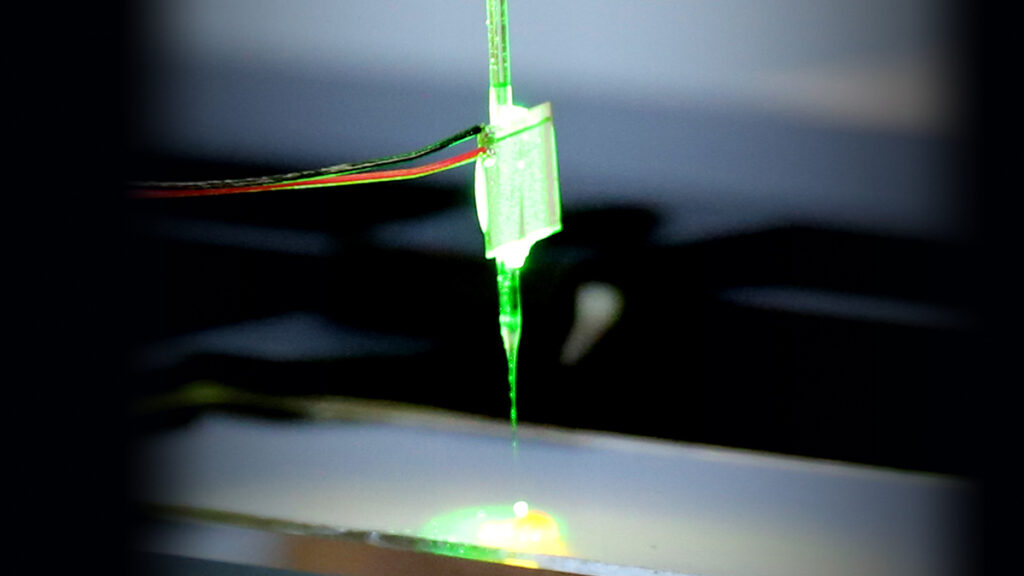When picturing robotic arms, one’s mind may instantly jump to the large industrial machines that are the ever-growing backbone of industrial endeavours. Such an image however has never been able to be applied to the microscopic robotic world, until now.
Researchers at ETH Zurich have developed an ultrasonically actuated glass needle that can be attached to a robotic arm on a microscopic scale. Doing so allows for the pumping and mixing of minuscule amounts of liquid and the trapping of individual particles.
Ultrasound needle oscillations
Scientists led by ETH Professor Daniel Ahmed have managed to combine the worlds of conventional robotics and microfluidics, which until now have been difficult to automate and required bespoke expensive chips for each application. By developing a device that uses ultrasound and can be attached to a robotic arm they have unlocked the ability to perform a wide range of tasks in micro-robotic and microfluidic applications which can additionally be used to automate such tasks.
The device itself is a thin, pointed glass needle and a piezoelectric transducer that allows the needle to oscillate. These transducers are similar to those seen in ultrasound imaging devices, dental cleaning equipment, or even your regular loudspeaker. By varying the frequency at which the needle oscillates when dipped in a liquid, ETH researchers can create a 3D pattern composed of multiple vortices. Since the pattern is a result of the oscillation frequency, it allows for a great level of control which until now was impossible.
Applications of the technology
Following the announcement, the researchers at ETH were able to demonstrate several of the many applications possible with the new technology.
First, they managed to mix minuscule droplets of highly viscous liquids which have always been a challenge on this scale. As Professor Ahmed explained, “The more viscous liquids are, the more difficult it is to mix them. However, our method succeeds in doing this because it allows us to not only create a single vortex but to also efficiently mix the liquids using a complex three-dimensional pattern composed of multiple strong vortices.”
Second, the scientists managed to pump fluids accurately through a mini-channel system by creating a specific pattern of vortices and placing their newly developed oscillating glass needle next to the channel walls.
Third, they successfully used the new device alongside robotic assistance to trap fine particles that were present within the fluids. Such a feat was achieved due to the particle’s size determining its reaction to the sound waves generated by the glass needle. Larger particles move toward the oscillations where they accumulate. The researchers even took this method a step further, demonstrating how its uses are not limited to inanimate particles but also biological cells, successfully testing the device on fish embryos. Previously, manipulating and capturing microscopic particles in three dimensions was always a great challenge, something that “our micro-robotic arm makes easy,” says Ahmed. “Mixing and pumping liquids and trapping particles – we can do it all with one device,” he went on to say.
Professor Ahmed followed up the demonstrations by saying: “Until now, advancement in large conventional robotics and microfluidic applications have been made separately. Our work helps to bring the two approaches together.” This breakthrough could mean that future microfluidic systems could be designed in a similar way to current robotic systems. Just like the machines in factories today, a single programmed device could be set up to handle a variety of automated tasks on a microscopic scale. Additionally, the devices use in the mainstream would wave goodbye to the previously expensive bespoke microfluidic chips that are made specifically for individual applications.
Moving forward, Ahmed and his team of scientists would like to combine several of the glass needles to create more complex vortex patterns in liquids. Beyond the current uses, he and his team also believe that their micro-robotic arms can see other uses such as the sorting of tiny objects, additive manufacturing, 3D printing and potentially introducing DNA into individual cells.
For more updates on the industry and smart tech, check out IoT Insider’s, smart homes, smart cities and news pages or our sister site, Electronic Specifier! Plus, you can delve deeper by commenting below or visiting our LinkedIn page.
